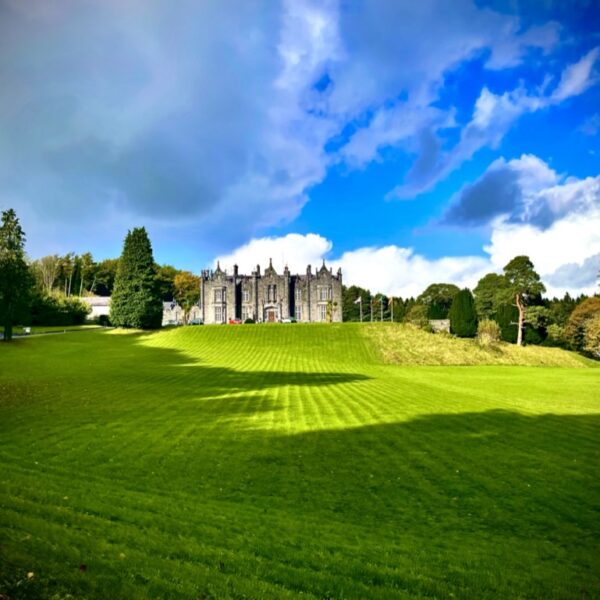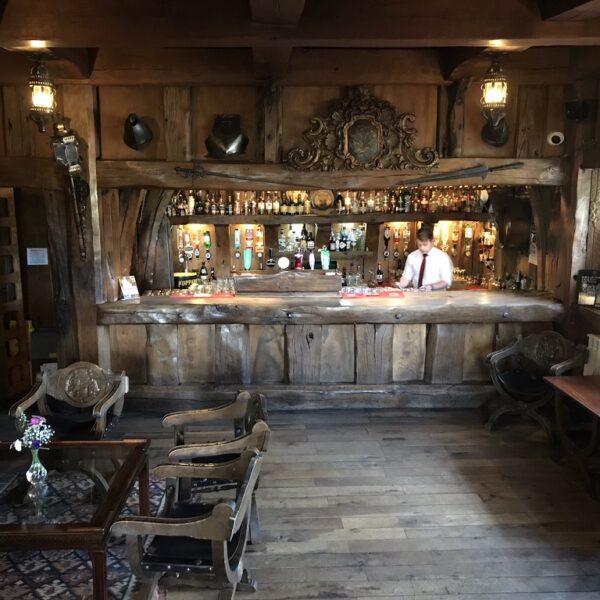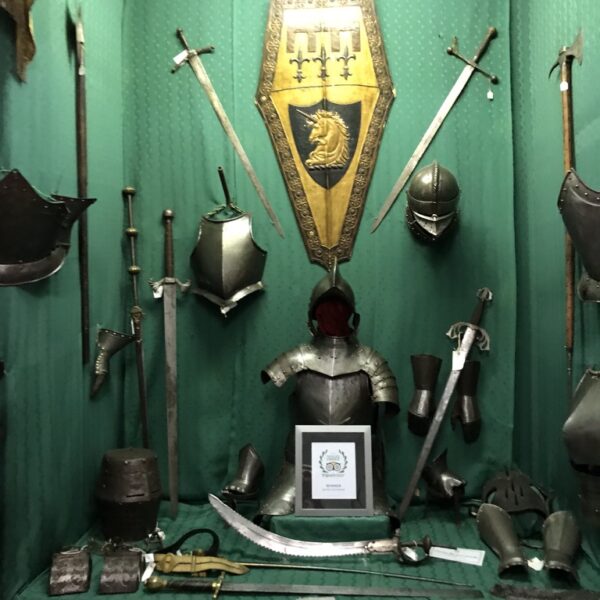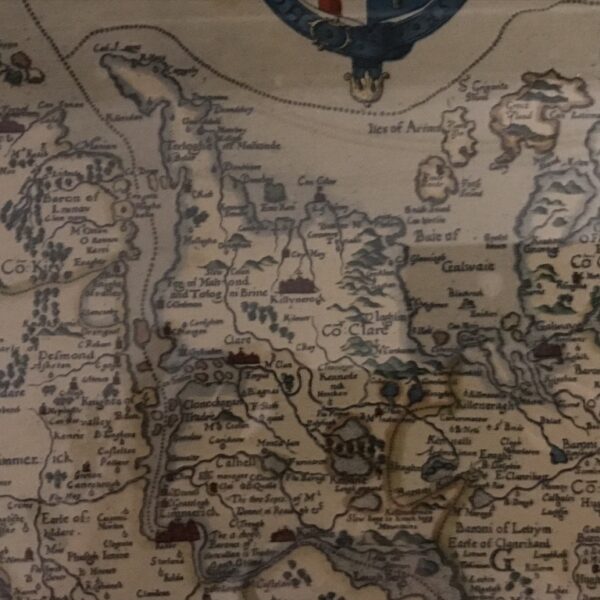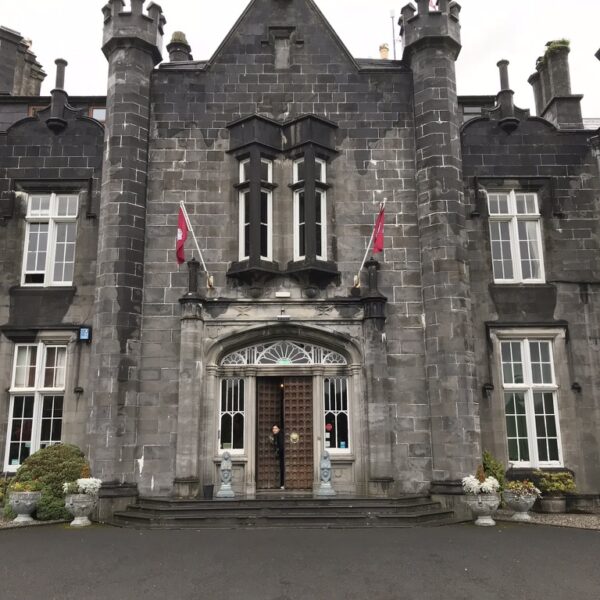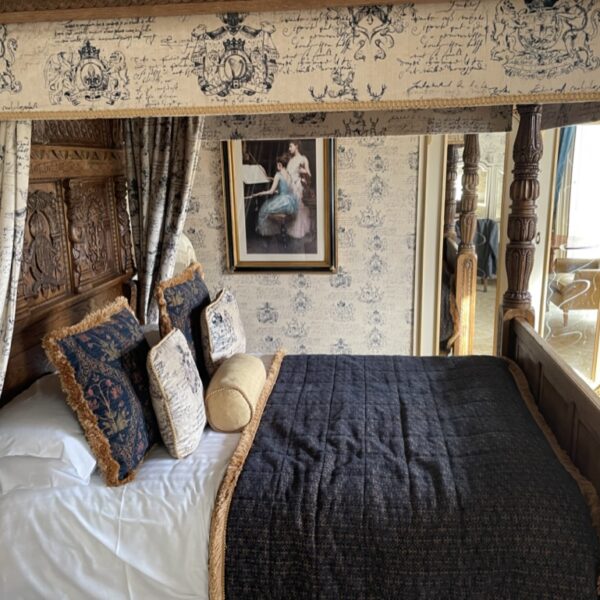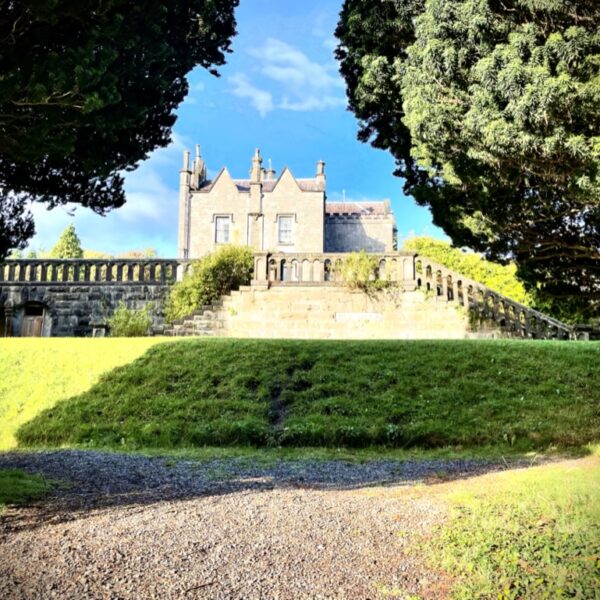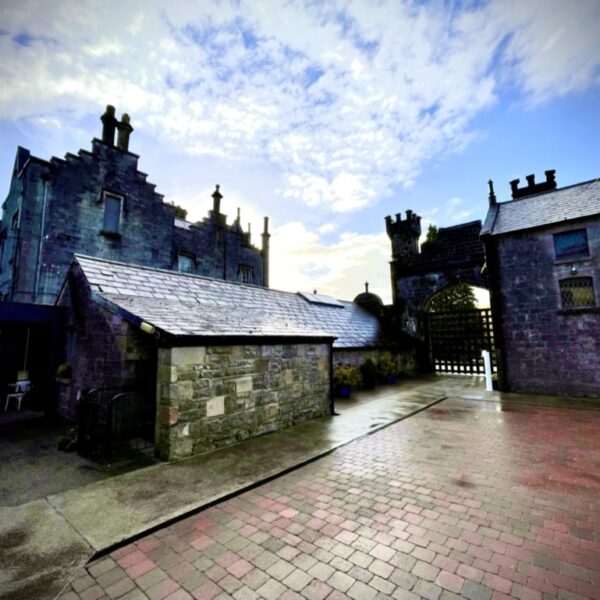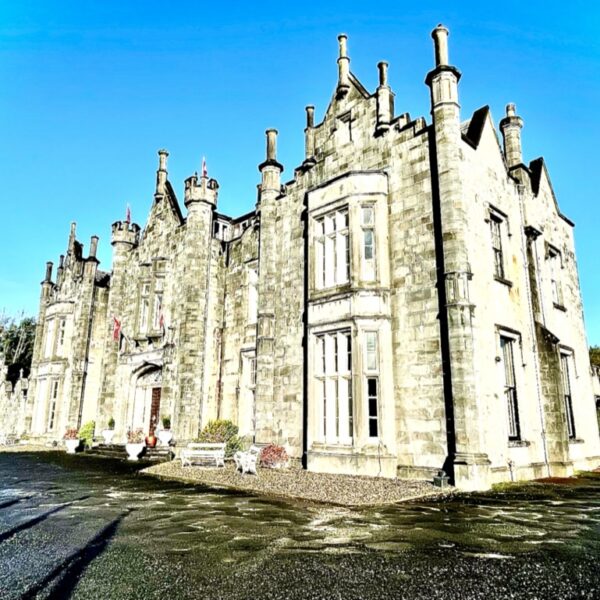Belleek Castle
January 21, 2025 2025-07-10 2:59Belleek Castle
Beleek Manor: A Sentinel of History and its Enduring Connection to the Ó Dubhda Clan
Where Ancient Roots Meet Modern Grandeur in the Heart of Ó Dubhda Lands
Nestled amidst the serene landscapes of County Mayo, Beleek Manor, now known as Belleek Castle Hotel, stands as a testament to centuries of Irish history. While its grand Neo-Gothic architecture speaks of a 19th-century vision, its foundations whisper tales of a much older past, intrinsically linked to the ancient territories of the Ó Dubhda clan. This page invites exploration into the layered history of this remarkable site, from its earliest spiritual roots to its current role as a vibrant heritage destination, and to understand its deep, albeit complex, connection to the enduring legacy of the Ó Dubhda.
I. Overview: Journey Through Time at Beleek Manor
Belleek Manor, widely recognized today as the Belleek Castle Hotel, is majestically situated on the outskirts of Ballina, County Mayo. This impressive four-star hotel and museum is set within 1,000 acres of the ancient Belleek Woods, bordering the tranquil banks of the River Moy. The property offers a distinctive blend of historical grandeur and contemporary hospitality, establishing itself as a significant cultural landmark in Ireland’s Western region.
The current imposing structure is a 19th-century manor house, constructed between 1825 and 1831. However, it is crucial to understand that this manor was erected upon the site of much older foundations. Historical accounts indicate the presence of an earlier 13th-century tower house and a medieval abbey or church on this very location. This layered history is paramount to comprehending the site’s profound connection to the Ó Dubhda clan. The distinction between the 19th-century manor and these earlier structures is vital for a clear understanding of the Ó Dubhda’s historical presence. While the later manor house was built by the Knox-Gore family, the documented existence of a 13th-century tower house and a medieval abbey on the site, with direct links to the Ó Dubhda clan, establishes a deep ancestral tie to the land itself, long before the current building existed.
The Ó Dubhda clan historically wielded significant influence over extensive areas of County Mayo and Sligo, including the immediate vicinity of Ballina. The clan’s presence in this region dates back centuries prior to the conception of the current manor, rooting their legacy deeply within the very soil upon which Belleek Manor now stands.
II. The Storied Past: Beleek Manor Through the Ages
A. Echoes of Ancient Foundations: The Ó Dubhda’s Early Presence
The ground beneath Belleek Manor holds a history that stretches back far beyond the 19th-century construction. The current manor is reputedly built on the site of a 13th-century tower house. More significantly for the Ó Dubhda clan, the grounds of Belleek Manor are home to the ruins of an old church. Local tradition asserts that St. Patrick himself founded the church of Cill Mor Muaidhe here, a site from which the name Kilmoramoy is believed to be derived. This ancient spiritual connection links the site to the earliest Christianization of Ireland, placing it within a sacred historical context.
Further historical records reinforce a direct Ó Dubhda connection to the medieval abbey that once stood on this site. The Abbey is thought to have been founded during the time of Teige Riagh O’Dubhda, a prominent clan chief. Additionally, annals from 1402 record Murtagh, son of Donogh O’Dubhda, being interred at Ardnaree, a nearby location. These accounts firmly establish the Ó Dubhda clan as patrons and figures of considerable importance at this very location many centuries ago. This ancient and direct connection to the church and abbey site on the grounds of Belleek Manor provides a powerful link for the Ó Dubhda clan, predating any later associations with other families. It highlights the clan’s deep historical roots and their patronage of significant religious sites within their traditional territory.
From the 8th to the 15th centuries, the Ó Dubhda clan reigned as the Kings of Uí Fiachrach Muaidhe, a sub-kingdom within Connacht, with their expansive territory encompassing parts of Mayo, including the Tirawley region where Ballina is situated. Their enduring presence and profound influence in the Ballina area were integral to the historical fabric of the region.
B. Shifting Tides: The Knox-Gore Era and the Broader Historical Landscape
The current Belleek Manor was commissioned and constructed by Sir Francis Knox-Gore, 1st Baronet, between 1825 and 1831. The Knox-Gore family, through the marriage of Mary Gore to Francis Knox, came into possession of the estate. This lineage traces back to the Earls of Arran (the Gore family), who had been granted 14,000 acres in Ballina under the 1662 Act of Settlement. Over generations, this family significantly expanded the estate to a remarkable 33,000 acres, residing there until 1942.
While the query mentions “formerly a Burke castle,” the direct ownership lineage of Belleek Manor does not explicitly identify it as a Burke stronghold. Instead, the 13th-century tower house that preceded the current manor was the ancestral home of the Earls of Arran (Gore family). However, the Burke family (also known as the House of Burgh or de Burgo) was indeed a dominant Anglo-Norman dynasty in Connacht from the 13th to the 20th centuries, holding substantial land in County Mayo. This historical context is important for understanding the regional dynamics. The Ó Dubhda clan’s history is notably marked by their remarkable ability to “hold their territory intact against the superior forces of the Burkes and Birminghams.” This ongoing struggle for land and power between the native Gaelic clans, such as the Ó Dubhda, and the Anglo-Norman families like the Burkes, was a defining characteristic of medieval and early modern Connacht. For instance, Moyne Abbey, located just 12km north of Ballina, was founded by a McWilliam Bourke in 1460, illustrating the significant Burke presence and influence in the wider region. Concurrently, the Ó Dubhda clan constructed their own fortifications, such as Castleconnor near Ballina, around 1520, as a tangible assertion of their enduring strength and territorial claims. The historical presence of the Burkes in the broader region and their documented conflicts with the Ó Dubhda clan highlight the complex and often contentious land dynamics that characterized Connacht for centuries. This regional context clarifies why the idea of a “Burke castle” might be associated with the area, even if this specific manor was not directly owned by them.
C. From Private Estate to Public Gem: The Modern Transformation
Following the Knox-Gore family’s departure in 1942, driven by rising maintenance costs, Belleek Manor underwent several changes in ownership, including periods under the Beckett family and the Mayo County Council. During the 1950s, it even served a period as a sanatorium. These transitions illustrate the economic challenges inherent in maintaining large estates in post-war Ireland, where properties often faced abandonment or even demolition to avoid tax burdens.
A pivotal moment occurred in 1961 when Marshall Doran, a retired merchant navy officer and passionate antiquarian, acquired the property. With considerable personal dedication and skill, he embarked on an extensive restoration of the manor, ultimately transforming it into the Belleek Castle Hotel, which opened its doors in 1970. This conversion from a private residence to a public-facing hotel exemplifies a common strategy for the adaptive reuse of historic properties, transforming a financial burden into a sustainable heritage enterprise. Today, Belleek Castle continues to operate as a family-run establishment, managed by Marshall’s son, Paul Doran, and Maya Nikolaeva. This modern incarnation of the manor serves as a contemporary guardian of the region’s complex history, making it accessible to a wider audience, including those with an interest in clan heritage.
III. Architectural Marvels: Unveiling Beleek Manor’s Design
A. Neo-Gothic Grandeur: The 19th-Century Manor
The current Belleek Manor is a striking architectural achievement, exemplifying the Neo-Gothic style prevalent in the 19th century, having been built between 1825 and 1831. Its design thoughtfully incorporates elements of both Tudor and Gothic architectural traditions. The design is widely attributed to the celebrated Irish Victorian architect John Benjamin Keane, though some sources also suggest Frederick Darley Junior as a potential contributor.
Key features that define its distinctive appearance include prominent turrets, decorative finials, an elegant Palladian-style frontage, intricately decorated vaulted ceilings, elaborate wood-panelled walls, and grand mullioned windows. The manor house itself is structured as a five-bay, two-storey building with a basement. A notable later addition is the gate tower, constructed in the 1870s based on designs by James Franklin Fuller. The entire manor house, along with a nearby mausoleum and its 19th-century entrance archway, are officially recognized as protected structures by Mayo County Council, underscoring their significant architectural and historical value.
B. Traces of the Past: Earlier Structures and Adaptations
The current 19th-century manor stands on the reputed site of a 13th-century tower house. This earlier fortification would have served as a defensive stronghold, characteristic of the period, likely reflecting the turbulent era of shifting power dynamics in Connacht. The evolution of the site from a defensive tower house to an opulent 19th-century manor house illustrates the changing nature of power, wealth, and societal needs in Ireland over centuries. It reflects a transition from feudal power and military necessity to an emphasis on comfort and aesthetic grandeur.
Furthermore, the grounds are home to the remnants of an old church, believed to be the ancient church of Cill Mor Muaidhe, potentially founded by St. Patrick himself. This indicates a continuous spiritual and residential presence on the site for well over a millennium, with the modern manor representing the latest iteration of human occupation and development. This progression from military/religious strongholds to grand residences, and then to a modern hotel, mirrors broader historical shifts from periods of intense clan conflict to more settled, albeit still hierarchical, landownership, and finally to economic adaptation through tourism.
C. The Estate and its Unique Features
Beyond the main manor house, the expansive 1,000-acre Belleek Woods provides a rich, historic natural setting, ideal for walking and cycling. The estate is bordered by the River Moy, a waterway renowned for its salmon.
Internally, the hotel boasts unique features that reflect Marshall Doran’s deep passion for antiquities. The “Armada Bar” is a particularly notable example, partially constructed from salvaged oak timber recovered from a 16th-century Spanish shipwreck in Killala Bay. The Marshall Doran Collection, housed within the castle’s museum, is a significant highlight. It comprises one of Ireland’s finest private collections of medieval armour and weaponry, alongside fossils and even Grace O’Malley’s reputed bed. This extensive collection adds a profound layer of historical intrigue and authenticity to the visitor experience, connecting guests directly with centuries of Irish heritage.
IV. Legends and Lore: Tales from Beleek Manor’s Shadows
A. The Ancient Church and St. Patrick’s Legacy
Within the very grounds of Belleek Manor, local tradition preserves the belief that St. Patrick, Ireland’s revered patron saint, founded the ancient church of Cill Mor Muaidhe. This site is considered the origin of the name Kilmoramoy. An ancient Christian monument, engraved with the “Crucia Christi” (a cross within three concentric circles), found on the site, is further attributed to St. Patrick’s historical presence. This deep spiritual connection links the site to the earliest Christianization of Ireland, establishing it as a place of profound historical and religious significance.
Further reinforcing the site’s ancient importance to the Ó Dubhda clan, the medieval abbey on the grounds is said to have been founded during the time of Teige Riagh O’Dubhda, a prominent clan chief. This indicates that the Ó Dubhda clan’s patronage and influence extended to this significant religious site, weaving their history directly into the fabric of Belleek’s ancient past. The presence of a St. Patrick-linked church and an abbey founded by an Ó Dubhda chief on the Belleek Manor site provides a powerful, ancient, and direct connection for the Ó Dubhda clan, predating any later associations with other families. This historical evidence underscores the clan’s deep, long-standing claim to the land and their significant role as patrons of ecclesiastical centers within their territory.
B. Echoes of Clan Resilience in the Landscape
While specific folklore directly tied to the Ó Dubhda within the walls of the current Belleek Manor is not extensively documented, the manor stands firmly within the ancestral lands of the Ó Dubhda clan. The clan was a formidable maritime power in the 12th and 13th centuries, constructing approximately 20 castles, often referred to as “10-Pound Castles,” across their territory in Northwest Connacht.
Their resilience is a recurring theme in historical accounts, as they “managed to hold their territory intact against the superior forces of the Burkes and Birminghams.” This constant struggle for sovereignty and land in County Mayo, where the Burkes were also a powerful presence, defines much of the regional history. The Ó Dubhda’s own castle at Castleconnor, near Ballina, built by Conor O’Dowd around 1520, serves as a tangible reminder of their enduring presence and strategic importance in the Moy Valley. Therefore, Belleek Manor, although later built by other families, is situated in a landscape steeped in the Ó Dubhda’s long and proud history of defending their ancestral homeland. The site itself, with its ancient foundations, is a testament to the layered history of the region and the clan’s deep, historical roots that precede later land changes.
C. A Shared Heritage in the Moy ValleyWhile the 19th-century Belleek Manor was constructed by the Knox-Gore family, its geographical location is profoundly embedded in the historical landscape of the Ó Dubhda clan. The River Moy, which gracefully flows alongside Belleek, was a vital artery within the Ó Dubhda’s ancient kingdom of Uí Fiachrach Muaidhe. The clan’s strategic castles, such as Castleconnor, built along the Moy, underscore their historical control over these crucial waterways.
The documented presence of the ancient church and abbey site on Belleek Manor’s grounds, with its direct links to Teige Riagh O’Dubhda and the venerable St. Patrick, firmly establishes the Ó Dubhda’s ancient and enduring connection to this specific piece of land. This makes Belleek Manor a significant point of interest within the broader narrative of the clan’s legacy in County Mayo, even if its most recent iteration is not directly tied to Ó Dubhda ownership. The site serves as a powerful reminder of the layered history of the region and the clan’s deep, historical roots that precede later land changes and ownership shifts.
VI. Visiting Beleek Castle Today: A Glimpse into the Past
A. Location & Access
Belleek Castle Hotel is located at Garrankeel, Ballina, County Mayo, F26 KV04, Ireland. It is conveniently situated approximately 2 km north of Ballina town center, nestled within the expansive Belleek Woods. The property operates as a four-star hotel and museum, offering public access through guided tours. It is readily accessible by car, with complimentary self-parking available on site. It is important to note that this Belleek Castle is distinct from the town of Belleek in County Fermanagh, which is renowned for its pottery.
Guided tours are offered daily at 11 am, 2 pm, and 4 pm. The grounds are open to visitors from May to September between 11 am and 4 pm, and from October to April between 2 pm and 4 pm. Admission fees apply: €10 for adults, €7.50 for children, and €30 for a family ticket. For hotel guests, check-in commences at 3 PM and concludes at 9 PM, with check-out by noon.
B. What to Expect
Visitors to Belleek Castle can anticipate a unique and immersive experience within a magnificent Neo-Gothic castle setting, enveloped by ancient forest. Key highlights include the Marshall Doran Collection, which stands as one of Ireland’s finest private collections of medieval armour, weaponry, and fossils, notably featuring Grace O’Malley’s reputed bed.
The castle also boasts the distinctive Armada Bar, ingeniously crafted from salvaged Spanish shipwreck timber, and the acclaimed Library Restaurant, offering exquisite fine dining prepared with local ingredients. Guests staying at the hotel can enjoy luxurious rooms adorned with period furnishings and traditional four-poster beds. The extensive Belleek Woods provides miles of scenic walking and cycling trails, and the adjacent River Moy is celebrated for its salmon fishing opportunities.
C. Important Considerations
It is advisable for prospective visitors to consult the official Belleek Castle website (belleekcastle.com) or contact the hotel directly for the most current information regarding opening hours, tour availability, and any special events, as these may vary seasonally. Visitors exploring the grounds should wear sturdy footwear. As the property is a functioning hotel, respect for the privacy of its guests is appreciated. It is also important to note that pets are not permitted on the property. The castle frequently serves as a popular venue for weddings and other private events.
Conclusions
Belleek Manor, now known as Belleek Castle Hotel, stands as a complex historical site, offering a rich tapestry of Irish heritage. While the current 19th-century Neo-Gothic manor was constructed by the Knox-Gore family, its foundations and surrounding lands hold profound and ancient connections to the Ó Dubhda clan. The documented presence of an ancient church, potentially founded by St. Patrick, and a medieval abbey linked to Teige Riagh O’Dubhda directly on the manor’s grounds, firmly establishes the Ó Dubhda clan’s deep, historical roots and patronage in this specific location, long predating later ownership.
The initial perception of it being “formerly a Burke castle” highlights the significant historical interactions and territorial disputes between the native Gaelic Ó Dubhda clan and the powerful Anglo-Norman Burke family in Connacht. Although the current manor was not a Burke stronghold, the broader region of Mayo was a historical battleground where the Ó Dubhda steadfastly maintained their territory against formidable forces, including the Burkes. This context underscores the Ó Dubhda clan’s enduring resilience and their long-standing claim to the ancestral lands of the Moy Valley.
The transformation of Belleek Manor into a hotel and museum under Marshall Doran’s stewardship represents a successful adaptive reuse of a historic property. This conversion has ensured the preservation of the site and its layered history, making it accessible to a wider audience. The hotel’s operations, including guided tours and the Marshall Doran Collection, now serve as a modern conduit for the public to engage with the complex and rich history of the region, including the ancient legacy of the Ó Dubhda clan. Thus, Belleek Castle, in its contemporary form, functions as a valuable point of connection for the Ó Dubhda clan, allowing their narrative to be shared and their deep historical ties to this land to be recognized and celebrated.
Beleek Manor
Caisleán Béal Leice (Castle of the Flagstone Mouth)
54°07'59.9"N, 9°08'43.8"W
Belleek Woods, Garrankeel
Ballina, County Mayo, Ireland
Tower house (13th-century, now lost)
Later converted into a Neo-Gothic manor (19th-century) on medieval foundations
c. 13th century (Ó Dubhda clan)
Manor house constructed 1825–1831 by Knox-Gore family
Not destroyed – original tower house no longer exists
Original medieval structures likely fell into ruin before the 19th century
Current structure is preserved as a heritage hotel and museum
Located within Belleek Woods on the River Moy
Accessible via Belleek Castle Hotel
Open to the public through hotel operations and guided tours
Built upon ancestral lands of the Ó Dubhda clan
13th-century tower house and church linked to Teige Riagh Ó Dubhda
Abbey on-site potentially founded by the Ó Dubhdas
Documented burial of Ó Dubhda family members nearby; deep ecclesiastical and territorial ties
Now operating as Belleek Castle Hotel, the manor preserves and showcases the layered heritage of the region, from early Christian roots to the Ó Dubhda’s medieval legacy, and onward through 19th-century Anglo-Irish gentry to modern restoration and cultural tourism

